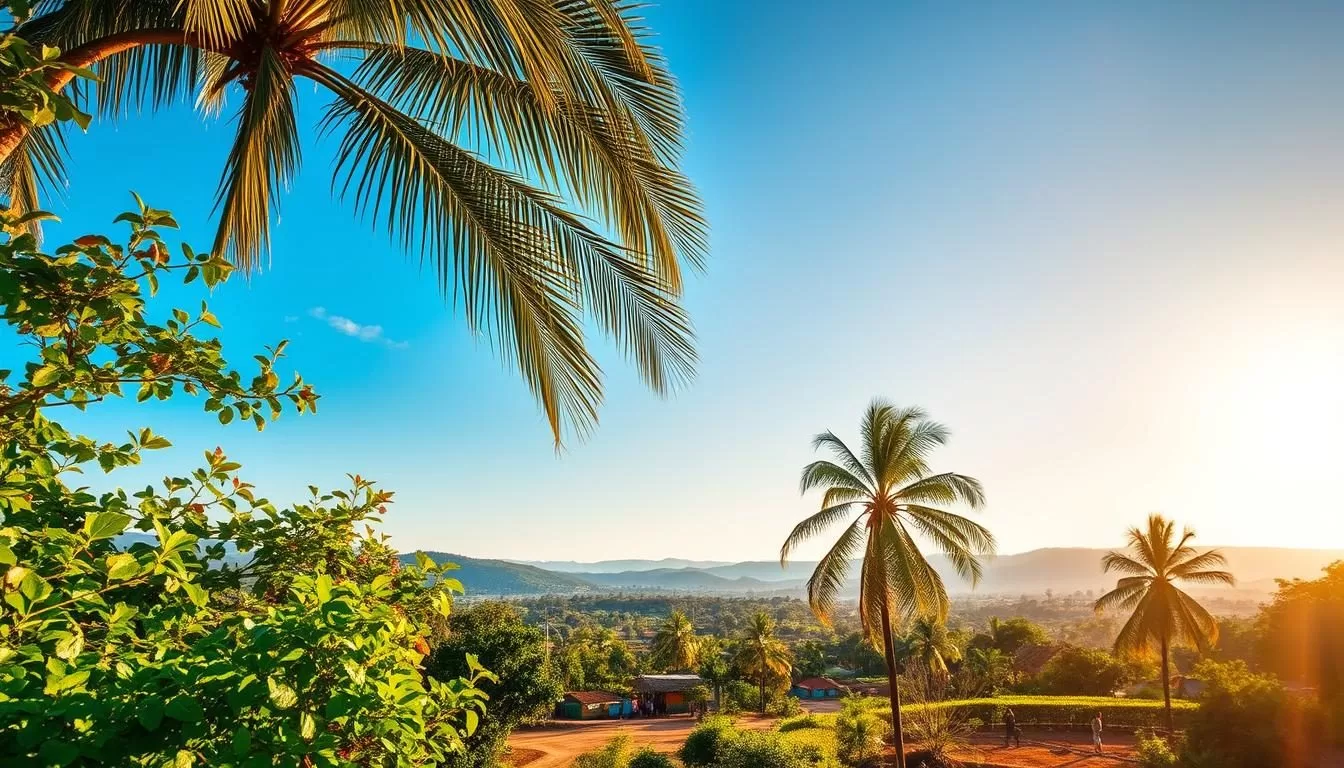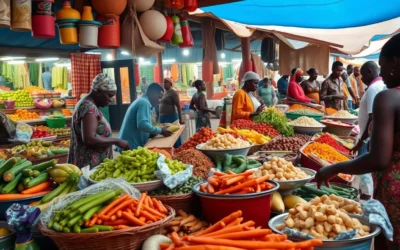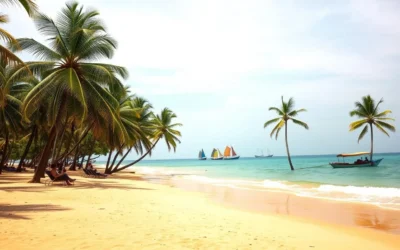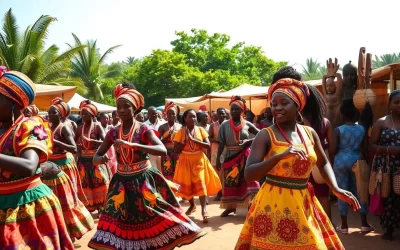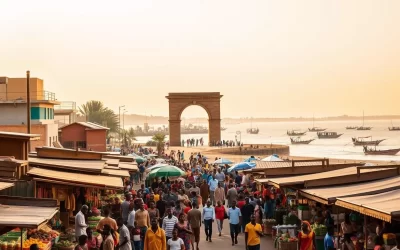✓ Accommodations✓ Flights✓ Rental Cars✓ Tours & Activities
Are you planning a trip to Gambia, a West African nation known for its stunning beaches and diverse wildlife? Understanding the country’s tropical climate and distinct weather patterns is crucial for a successful trip.
Gambia experiences two main seasons: wet and dry. The best time to visit depends on your preferences for weather conditions and crowd levels. This guide will help you determine the ideal time for your adventure based on weather patterns and special events throughout the year.
By choosing the right time to visit, you can make the most of your trip and enjoy all that Gambia has to offer.
Understanding Gambia’s Tropical Climate
Gambia’s geographical location near the equator ensures a tropical climate that remains warm throughout the year. This climate characteristic makes Gambia an attractive destination for travelers seeking warm weather.
Overview of Gambia’s Weather Patterns
Gambia enjoys a tropical climate with consistently warm temperatures due to its proximity to the equator. The country’s weather patterns are primarily divided into two distinct seasons: the dry season and the wet season, each offering unique experiences for visitors.
The annual temperature variations are relatively minimal, with temperatures rarely dropping below 70°F (21°C) even during the coolest months. Humidity levels fluctuate significantly between weather conditions, affecting comfort levels for travelers.
| Season | Characteristics | Temperature Range |
|---|---|---|
| Dry Season | Low humidity, clear skies | 70°F – 90°F (21°C – 32°C) |
| Wet Season | High humidity, rainfall | 75°F – 85°F (24°C – 30°C) |
The Two Main Seasons: Wet and Dry
Gambia’s climate is characterized by two main seasons. The dry season, which spans from November to May, is marked by low humidity and clear skies, making it ideal for outdoor activities. In contrast, the wet season from June to October brings higher humidity and significant rainfall, resulting in lush landscapes.
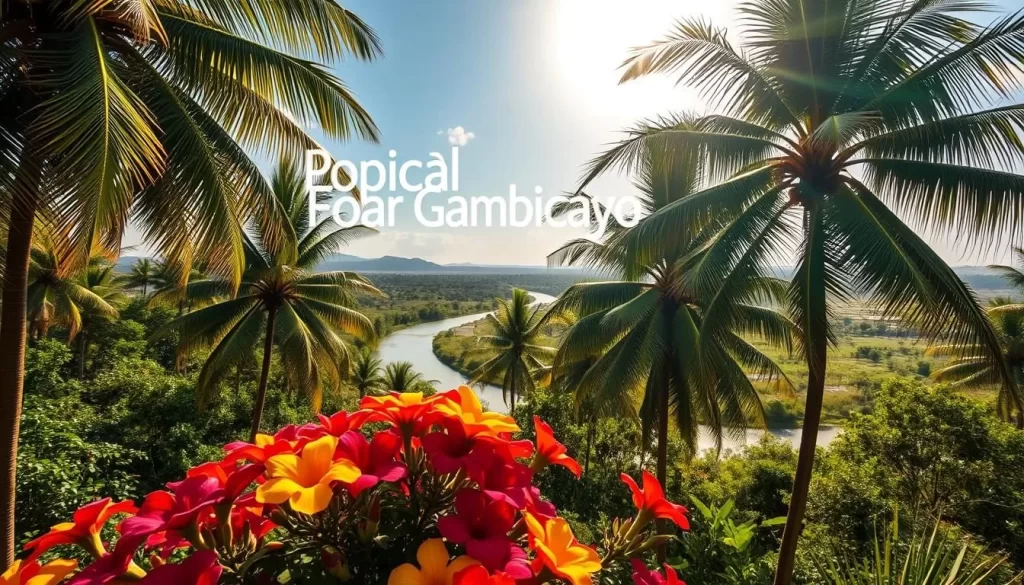
Understanding these weather patterns is crucial for planning your trip to Gambia, ensuring you make the most of your year-round warm tropical climate.
The Dry Season: November to May
The dry season in Gambia, which lasts from November to May, offers ideal weather conditions for travelers. During this period, you can enjoy the country’s beautiful landscapes without the discomfort of excessive heat or rain.
Temperature and Humidity Levels
The dry season is characterized by pleasantly warm temperatures that rarely exceed 35°C (95°F). Humidity levels remain relatively low, making the heat much more comfortable compared to the wet months. You can expect a comfortable climate, perfect for outdoor explorations.
Sunshine Hours and Rainfall Expectations
During the dry season, you’ll enjoy abundant sunshine with approximately 9-10 hours of sun daily. This creates perfect conditions for activities like beach relaxation and outdoor explorations. Rainfall is minimal during these months, ensuring that your trip is not disrupted by weather-related issues.
Ideal Outdoor Activities During This Period
The dry season is the best time for a wide range of outdoor activities, including beach relaxation, river cruises, bird watching, and exploring the country’s natural reserves. The clear skies and predictable weather patterns make it ideal for maximizing your outdoor experiences.
| Activity | Nov | Dec | Jan | Feb | Mar | Apr | May |
|---|---|---|---|---|---|---|---|
| Beach Relaxation | Yes | Yes | Yes | Yes | Yes | Yes | Yes |
| River Cruises | Yes | Yes | Yes | Yes | Yes | Yes | Yes |
| Bird Watching | Yes | Yes | Yes | Yes | Yes | Yes | Yes |

Peak Tourist Season: December to April
December to April marks the peak tourist season in Gambia, attracting visitors with its warm and sunny weather. This period is ideal for tourists, especially those from Europe, looking to escape the cold winter months.
Why Tourists Flock to Gambia in Winter
Winter is the perfect time for all sun lovers to visit Gambia. You can soak up the sun during the day and relax in the evenings with a cool breeze. The country hosts extravagant dinner galas in numerous hotels, making it a magical destination for Christmas and New Year celebrations.
Accommodation Rates and Availability
During the peak season, accommodation rates typically increase by 20-30%. It’s essential to book early as the best properties often reach full capacity weeks in advance. You should expect a lively atmosphere, especially around coastal resorts and popular attractions.
Popular Attractions and Experiences
Popular attractions like the Abuko Nature Reserve, Kachikally Crocodile Pool, and river cruises operate at full capacity during this time. These attractions offer enhanced services, but you’ll need to make advance reservations. Some of the experiences you can look forward to include:
- Exploring the natural beauty of Gambia’s reserves and parks
- Enjoying river cruises with breathtaking views
- Interacting with wildlife at the crocodile pools

Gambia: Best Months for a Weather-Savvy Trip
When planning a trip to Gambia, timing is everything to ensure a weather-savvy vacation. The country’s tropical climate means that the weather varies significantly throughout the year, impacting the quality of your experience.
January and February: Perfect Beach Weather
These months offer ideal beach conditions, with daytime temperatures around 30-32°C (86-90°F) and pleasant nights at 18-20°C (64-68°F). It’s the perfect time for sunbathing and enjoying water activities.
March and April: Warm but Comfortable
As the dry season continues, March and April remain warm but comfortable due to low humidity. These months are ideal for combining beach relaxation with cultural excursions, making them a great alternative to the peak winter months.
November and December: Beginning of the Dry Season
November and December mark the start of the dry season, offering increasingly favorable weather while avoiding the peak tourist crowds. You can enjoy Gambia’s attractions without the hustle and bustle, making for a more relaxed experience.
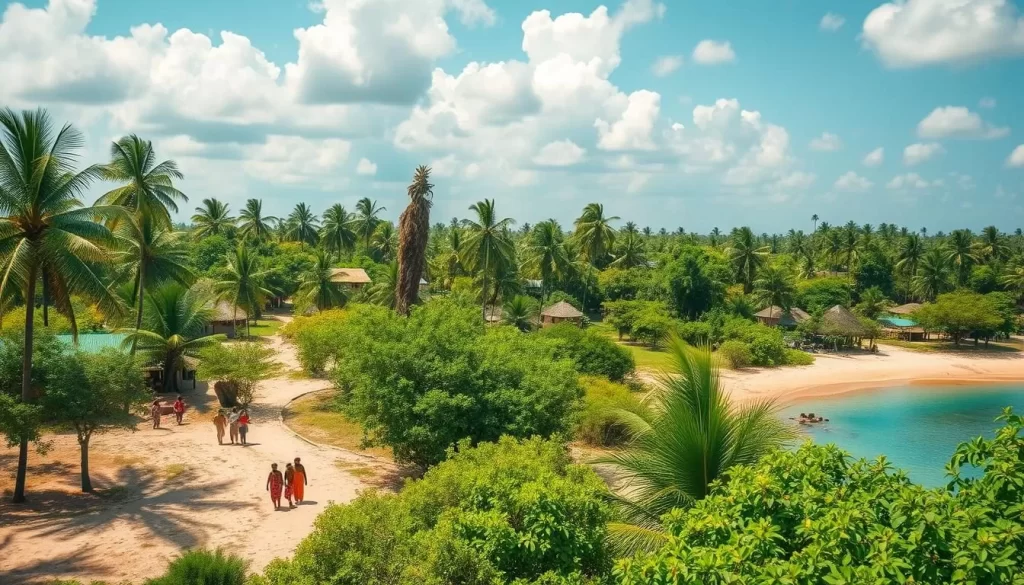
For the most balanced experience, consider visiting in February, which combines ideal weather with vibrant cultural activities and moderate tourist numbers. Each of these months offers unique advantages, allowing you to tailor your visit to your preferences for weather, crowds, and activities.
The Wet Season: June to October
The wet season in Gambia, which runs from June to October, transforms the country into a vibrant, tropical paradise. This period is marked by significant rainfall and high humidity, but it’s also a time when the landscape becomes particularly lush and green.
Rainfall Patterns and Humidity
During the wet season, Gambia experiences increased rainfall, with showers often being short and intense. The humidity levels can reach 80-90% on many days, contributing to the tropical feel. Rainfall typically occurs in the late afternoon or overnight, leaving the mornings relatively clear.
Temperature Variations
Despite the rain, the wet season brings temperatures that are actually slightly lower than in the dry season, typically 2-3°C cooler in July and August. However, it starts getting warmer again in September. You can still enjoy around 6 hours of sunshine daily, making it possible to plan outdoor activities.
Lush Landscapes and Natural Beauty
The wet season transforms Gambia’s landscapes into lush, vibrant greenery, offering spectacular scenery for photographers and nature enthusiasts. The country’s natural beauty is particularly pronounced during this time, making it a unique time to visit.
Shoulder Seasons: May and October
For travelers looking for a balance between pleasant weather and smaller crowds, Gambia’s shoulder seasons are worth considering. The months of May and October serve as transition periods between the wet and dry seasons, offering unique advantages.
Weather Characteristics
During May, Gambia experiences gradually increasing humidity but minimal rainfall, with pleasant temperatures ranging around 32-34°C (90-93°F) during the day. In contrast, October marks the end of the rainy season, with decreasing rainfall and humidity levels that improve as the month progresses, although occasional showers may still occur.
Benefits of Visiting During Transition Months
Visiting Gambia during these shoulder months provides several benefits. You can expect to encounter fewer crowds at popular attractions, with visitor numbers typically 40-50% lower than during the peak season from December to February. Additionally, accommodation rates are often 15-25% lower than peak season prices, offering better value while still providing a good chance of favorable weather conditions. This makes May and October an excellent time to visit Gambia, enjoying pleasant temperatures and avoiding the peak season hustle.
- Enjoy popular attractions without the peak season crowds.
- Benefit from lower accommodation rates.
- Experience pleasant weather during these months.
Overall, the shoulder seasons offer a great opportunity to explore Gambia under more relaxed conditions, making it an ideal time to visit for those seeking a more laid-back experience.
Wildlife Viewing Throughout the Year

Gambia is a year-round destination for wildlife viewing, with its diverse ecosystems supporting a vast array of species. You will love exploring the country’s wildlife during the wet season and will become a fan of the region’s natural beauty.
The country’s varied landscapes, from lush wetlands to dry savannas, create a perfect setting for a wide range of wildlife. The Abuko Nature Reserve and Kiang West National Park are just a couple of the many places where you can experience the rich biodiversity of Gambia.
Bird Watching Opportunities by Season
Gambia is renowned as a year-round birdwatcher’s paradise, with over 540 bird species making it one of Africa’s premier ornithological destinations. During the dry season (November-May), migratory species from Europe join resident birds, making January and February the peak months for bird watching.
In contrast, the wet season brings lush vegetation and abundant water sources, creating different bird watching opportunities as various species become more active and visible around rivers and wetlands.
River and Land Wildlife Experiences
River cruises along the Gambia River provide excellent opportunities to observe hippos, crocodiles, and various monkey species. The best viewing conditions typically occur during the early morning hours, regardless of the season.
On land, the diverse ecosystems support a wide range of wildlife, from the majestic to the tiny. Exploring Gambia’s national parks and nature reserves offers a chance to experience the country’s natural beauty and rich wildlife.
Cultural Festivals and Events Calendar
Throughout the year, Gambia celebrates numerous cultural festivals and events that offer a glimpse into its vibrant culture and traditions. These events are a great way to experience the local culture and connect with the people.
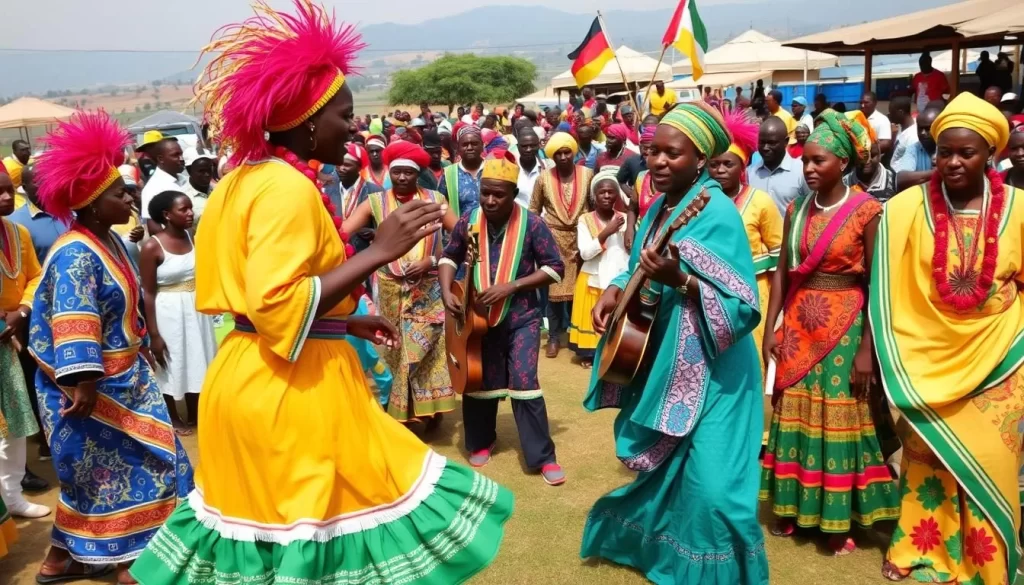
Dry Season Celebrations
During the dry season, you can witness significant celebrations such as Independence Day on February 18th, featuring colorful parades, traditional music, and dance performances. The Roots Homecoming Festival, typically held in May or June, is another highlight, connecting the African diaspora with their ancestral heritage and offering a powerful cultural experience.
Wet Season Traditional Events
Even during the wet season, Gambia’s cultural calendar remains vibrant with traditional events, including harvest festivals in rural communities. These events provide an authentic glimpse into cultural practices maintained for generations. You can also experience the diverse spiritual traditions through various religious festivals celebrated throughout the year.
Practical Packing Tips by Season
The key to a hassle-free trip to Gambia lies in understanding the seasonal weather patterns and packing accordingly. Whether you’re visiting during the dry or wet season, being prepared is essential for a comfortable and enjoyable experience.
Dry Season Essentials
For the dry season, which spans from November to May, pack lightweight, breathable clothes made from natural fabrics like cotton and linen. Don’t forget to include high-SPF sunscreen, a wide-brimmed hat, sunglasses, and a reusable water bottle to stay protected and hydrated during the intense sunshine hours.
Wet Season Must-Haves
When visiting during the wet season (June-October), bring quick-drying clothes, a lightweight waterproof jacket, and water-resistant footwear to handle the frequent rain showers. A small, packable umbrella and waterproof bags for electronics are also practical additions.
Year-Round Items for Gambia
Regardless of the season, it’s essential to pack modest clothing for visiting religious sites and rural communities. Additionally, include insect repellent, a basic first-aid kit, and any personal medications to ensure you’re prepared for your trip.
Conclusion
The best time to visit Gambia is a question that depends on your preferences and interests. When planning your trip, it’s essential to consider what you want to experience. If you prioritize ideal weather and outdoor activities, the dry season from December to April is ideal. For a more budget-friendly option with fewer crowds, consider the shoulder seasons of May and October.
Your specific interests will also dictate the best time to visit. Whether you’re interested in bird watching, relaxing on the beach, or cultural immersion, Gambia has something to offer. With its warm hospitality and rich cultural heritage, Gambia ensures a memorable experience at any time of the year, provided you’re prepared for the seasonal conditions.
The above is subject to change.
Check back often to TRAVEL.COM for the latest travel tips and deals.
